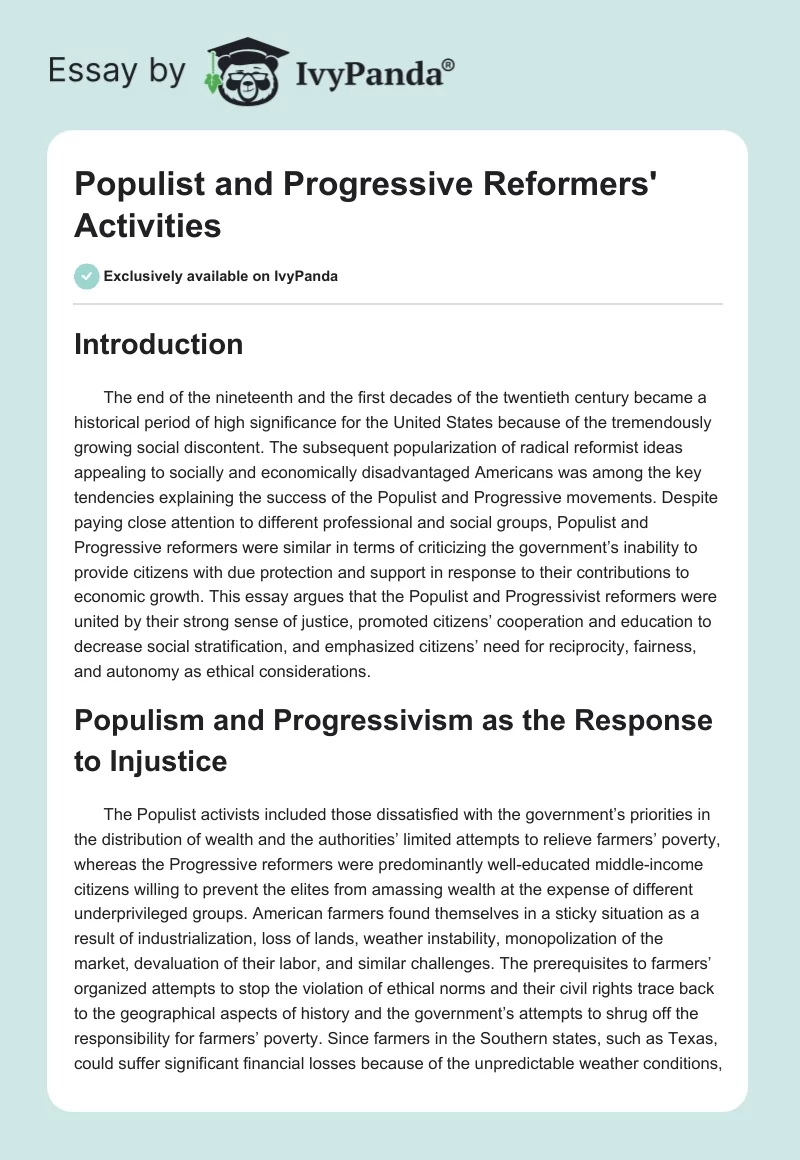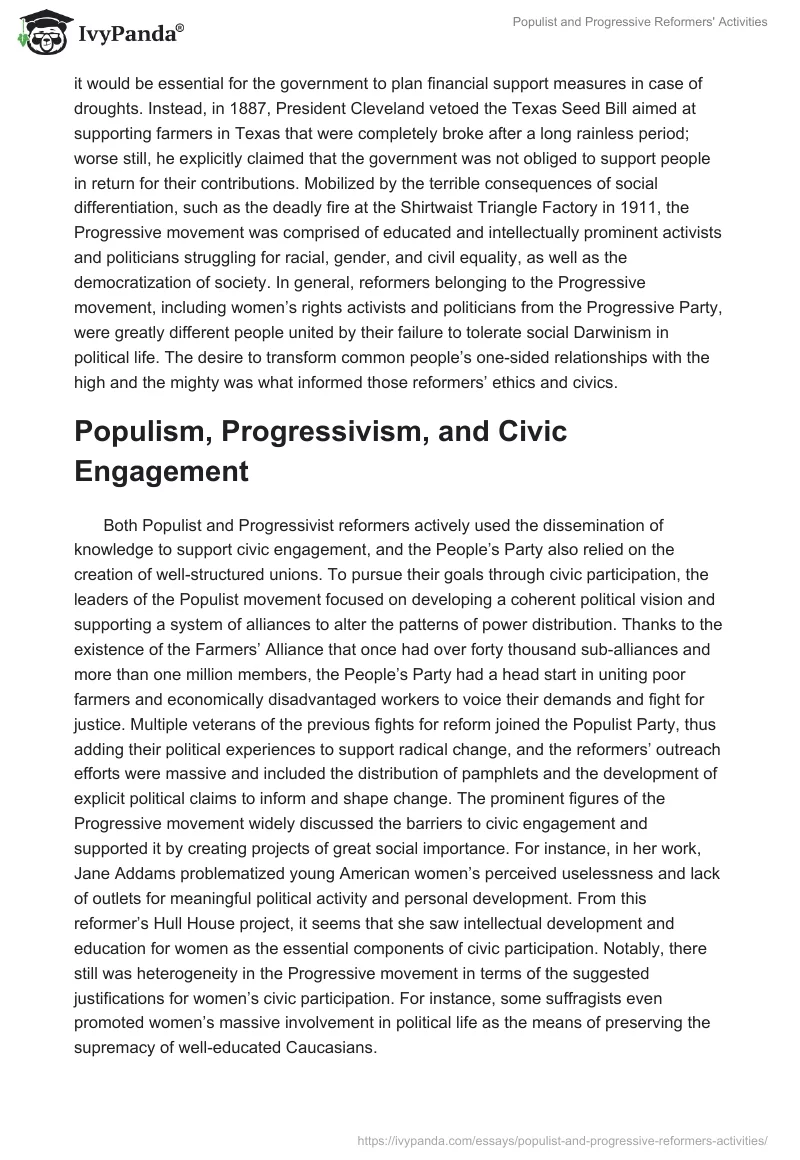Introduction
The end of the nineteenth and the first decades of the twentieth century became a historical period of high significance for the United States because of the growing social discontent. The subsequent popularization of radical reformist ideas appealing to socially and economically disadvantaged Americans was among the key tendencies explaining the success of the Populist and Progressive movements.
Despite paying close attention to different professional and social groups, Populist and Progressive reformers were similar in terms of criticizing the government’s inability to provide citizens with due protection and support in response to their contributions to economic growth. This essay argues that the Populist and Progressivist reformers were united by their strong sense of justice, promoted citizens’ cooperation and education to decrease social stratification, and emphasized citizens’ need for reciprocity, fairness, and autonomy as ethical considerations.
Populism and Progressivism as the Response to Injustice
The Populist activists included those dissatisfied with the government’s priorities in the distribution of wealth and the authorities’ limited attempts to relieve farmers’ poverty, whereas the Progressive reformers were predominantly well-educated middle-income citizens willing to prevent the elites from amassing wealth at the expense of different underprivileged groups. American farmers found themselves in a sticky situation as a result of industrialization, loss of lands, weather instability, monopolization of the market, devaluation of their labor, and similar challenges. The prerequisites to farmers’ organized attempts to stop the violation of ethical norms and their civil rights trace back to the geographical aspects of history and the government’s attempts to shrug off the responsibility for farmers’ poverty. Since farmers in the Southern states, such as Texas, could suffer significant financial losses because of the unpredictable weather conditions, it would be essential for the government to plan financial support measures in case of droughts. Instead, in 1887, President Cleveland vetoed the Texas Seed Bill aimed at supporting farmers in Texas that were completely broke after a long rainless period; worse still, he explicitly claimed that the government was not obliged to support people in return for their contributions. Mobilized by the terrible consequences of social differentiation, such as the deadly fire at the Shirtwaist Triangle Factory in 1911, the Progressive movement was comprised of educated and intellectually prominent activists and politicians struggling for racial, gender, and civil equality, as well as the democratization of society. In general, reformers belonging to the Progressive movement, including women’s rights activists and politicians from the Progressive Party, were greatly different people united by their failure to tolerate social Darwinism in political life. The desire to transform common people’s one-sided relationships with the high and the mighty was what informed those reformers’ ethics and civics.
Populism, Progressivism, and Civic Engagement
Both Populist and Progressivist reformers actively used the dissemination of knowledge to support civic engagement, and the People’s Party also relied on the creation of well-structured unions. To pursue their goals through civic participation, the leaders of the Populist movement focused on developing a coherent political vision and supporting a system of alliances to alter the patterns of power distribution. Thanks to the existence of the Farmers’ Alliance that once had over forty thousand sub-alliances and more than one million members, the People’s Party had a head start in uniting poor farmers and economically disadvantaged workers to voice their demands and fight for justice. Multiple veterans of the previous fights for reform joined the Populist Party, thus adding their political experiences to support radical change, and the reformers’ outreach efforts were massive and included the distribution of pamphlets and the development of explicit political claims to inform and shape change. The prominent figures of the Progressive movement widely discussed the barriers to civic engagement and supported it by creating projects of great social importance. For instance, in her work, Jane Addams problematized young American women’s perceived uselessness and lack of outlets for meaningful political activity and personal development. From this reformer’s Hull House project, it seems that she saw intellectual development and education for women as the essential components of civic participation. Notably, there still was heterogeneity in the Progressive movement in terms of the suggested justifications for women’s civic participation. For instance, some suffragists even promoted women’s massive involvement in political life as the means of preserving the supremacy of well-educated Caucasians.
The Two Movements and Ethical Considerations
Regarding ethical considerations informing the attempts to push reforms, Progressive reformers emphasized the interdependence of the classes and advocated for the relationships of reciprocal beneficence, whereas Populist leaders attached much importance to fairness and workers’ autonomy in managing their industries’ wealth. The People’s Party was founded in 1891 and took its roots in the Farmers’ Alliance. It presented the critical attempt of the Populist movement to reply to injustice towards poor farmers by pushing legislative and judicial reforms to stop corruption and other unfair practices used to the appropriate wealth produced by the working class. The core political strategy of the People’s Party was to play on common people’s exhaustion from feeding the region and getting almost nothing in return. For instance, the demands of the Omaha Platform of the People’s Party included recognizing the labor force as the possessors and producers of wealth, fair pensions, the implementation of the progressive income tax system, and the discontinuation of practices to silence the working majority. These demands properly illustrate the modern ethical principles of fairness, autonomy, and reciprocity. The ethic of reciprocity, in particular, the need to recognize the dependence of the wealthy on the working class, was also emphasized by the Progressives in their attempts to justify and push social reforms. For instance, in 1892, Jane Addams explained that the very opening of the Hull House had been informed by the idea of the mutual dependence of the upper and the lower class. However, unlike the Populists, the Progressives did not openly call the wealthiest and the powerful the true enemies of the working class and favored the principles of mutual beneficence and inter-class cooperation rather than the concentration of power in the hands of the disadvantaged.
Conclusion
To sum it up, the activities of the Populist and Progressive reformers that introduced new opportunities for common Americans were focused on searching for more radical or more cooperative ways to improve the representation of non-wealthy people’s interests. Prominent reformers’ methods to pursue their goals were closely interconnected with their understanding of individual citizens’ role in affecting their countries’ further political development and perspectives on cooperation between different social classes. From this viewpoint, the actions of the Populist reformers, such as the leaders of the People’s Party, were focused on engaging the masses of people to maximize their political influence. At the same time, both the People’s Party and humanistic Progressivists, such as Jane Addams, saw the dissemination of knowledge as the facilitators of change and emphasized reciprocity, fairness, and autonomy in their reformist activities.
Bibliography
Addams, Jane. “The Subjective Necessity for Social Settlements (1892)”. In The American Yawp Reader: A Documentary Companion to the American Yawp. Stanford: Stanford University Press, 2019-2020.
Baker, Andrew C., Nicholas Blood, Justin Clark, Dan Du, Caroline Bunnell Harris, David Hochfelder Scott Libson, Joseph Locke, Leah Richier, Matthew Simmons, Kate Sohasky, Joseph Super, and Kaylynn Washnock. “Capital and Labor.” In The American Yawp, edited by Joseph Locke and Ben Wright. Stanford: Stanford University Press, 2018.
Baker, Andrew C., Peter Catapano, Blaine Hamilton, Mary Anne Henderson, Amanda Hughett, Amy Kohout, Maria Montalvo, Brent Ruswick, Philip Luke Sinitiere, Nora Slonimsky, Whitney Stewart, and Brandy Thomas Wells. “The Progressive Era.” In The American Yawp, edited by Joseph Locke and Ben Wright. Stanford: Stanford University Press, 2018.
Betz, Jacob, David Hochfelder, Gerard Koeppel, Scott Libson, Kyle Livie, Paul Matzko, Isabella Morales, Andrew Robichaud, Kate Sohasky, Joseph Super, Susan Thomas, Kaylynn Washnock, and Kevin Young. “Life in Industrial America.” In The American Yawp, edited by Joseph Locke and Ben Wright. Stanford: Stanford University Press, 2018.
Journal of the House of Representatives. “Grover Cleveland’s Veto of the Texas Seed Bill (1887).” In The American Yawp Reader: A Documentary Companion to the American Yawp. Stanford: Stanford University Press, 2019-2020.
McPherson, Edward. “The Omaha Platform of the People’s Party (1892)”. In The American Yawp Reader: A Documentary Companion to the American Yawp. Stanford: Stanford University Press, 2019-2020.

